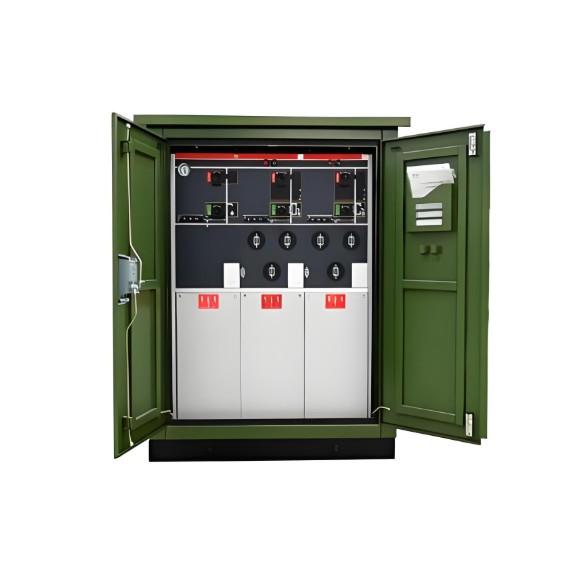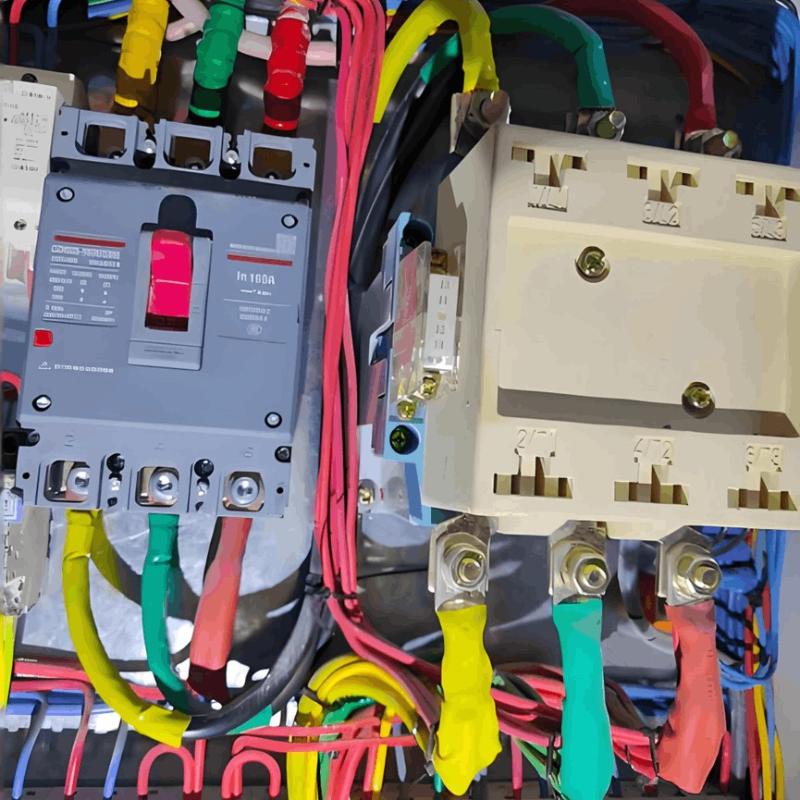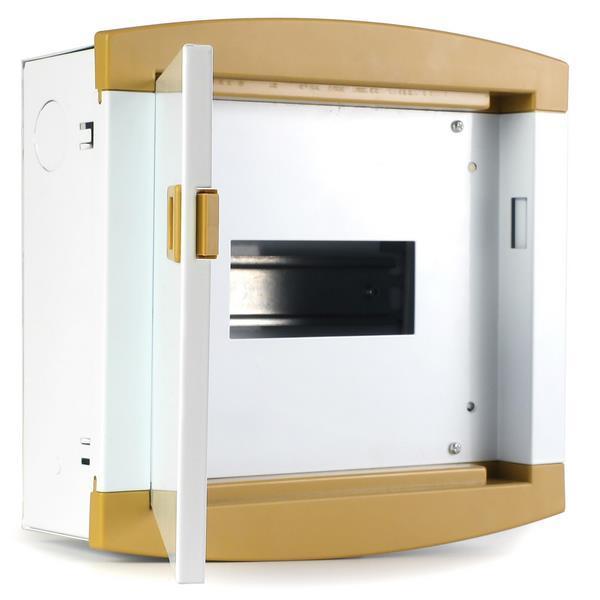आधुनिक कम वोल्टेज वितरण कैबिनेट मुख्यतया दो भागों से बना होता है: पैनल और आवरण। कैबिनेट पैनल की स्थापना के दौरान, "सुसंगत, सुंदर, सुरक्षित, और रखरखाव में आसान" यह सिद्धांत अपनाया जाना चाहिए। कैबिनेट सामग्री (जैसे, लकड़ी, स्टील) और स्थापना विधि (जैसे, सतह-स्थापित, डालेंद) के आधार पर वर्गीकृत किए जा सकते हैं। चीन के विद्युत उद्योग के निरंतर विकास के साथ, कम वोल्टेज वितरण कैबिनेटों के लिए स्वचालन स्तर और विश्वसनीयता की मांग लगातार बढ़ रही है।
1 आधुनिक कम वोल्टेज वितरण कैबिनेट के डिजाइन और कार्य का संक्षिप्त विवरण
आधुनिक कम वोल्टेज वितरण कैबिनेट विद्युत ग्रिड और अंतिम उपयोगकर्ताओं को जोड़ने का एक महत्वपूर्ण लिंक है। इसकी संचालन लचीलता और विश्वसनीयता विद्युत आपूर्ति की गुणवत्ता में सुधार के लिए आवश्यक है। ये कैबिनेट ग्रिड विद्युत आपूर्ति की लचीलता को प्रभावी रूप से बढ़ाते हैं और फ़ॉल्ट आउटेज का समय कम करते हैं। पारंपरिक कैबिनेटों के विपरीत, आधुनिक कैबिनेट अधिक स्वचालन और सूचना विज्ञान के स्तर के साथ आते हैं। उनकी विशेषताएं सामान्यतः फीडर लोड को प्रभावी रूप से विभाजित करने, लक्षित अकार्षक शक्ति की भरपाई करने, विद्युत प्रणाली के संचालन पैरामीटरों की वास्तविक समय में निगरानी करने, और व्यापक सुरक्षा कार्यों की पेशकश करने जैसी होती हैं। ये लाभ वितरण नेटवर्क की विश्वसनीयता और विद्युत गुणवत्ता को बहुत बढ़ाते हैं, ग्रिड के संचालन के दौरान वोल्टेज और शक्ति कारक जैसे पैरामीटरों को अनुकूलित करते हैं। इसके अलावा, उन्नत नियंत्रण प्रणाली डिजाइन के माध्यम से, वे अतिवोल्टेज, अतिधारा, और हार्मोनिक्स जैसी असामान्य स्थितियों से प्रभावी रूप से सुरक्षा प्रदान करते हैं, साथ ही वे अच्छी गतिक प्रतिक्रिया क्षमता भी रखते हैं।
2 विशिष्ट डिजाइन की विशेषताओं का विश्लेषण
2.1 कम वोल्टेज वितरण कैबिनेट का सर्किट डिजाइन
आधुनिक कम वोल्टेज वितरण कैबिनेट का सर्किट डिजाइन विद्युत स्कीमेटिक डिजाइन और चालकों का चयन शामिल होता है। इस पहलू के लिए निम्नलिखित विचारों का ध्यान रखा जाना चाहिए:
विद्युत स्कीमेटिक का डिजाइन: विद्युत स्कीमेटिक कम वोल्टेज वितरण कैबिनेट डिजाइन का सबसे मूलभूत पहलू है। डिजाइन प्रक्रिया के दौरान, डिजाइनरों को लोड की विशेषताओं, परिमाण, और आपूर्ति सर्किटों की विशेषताओं को व्यापक रूप से ध्यान में रखना चाहिए। उदाहरण के लिए, प्रत्येक सर्किट के लिए चालकों के अनुप्रस्थ क्षेत्र, प्रकार, सामग्री, और संरक्षण उपकरणों की प्रदर्शनशीलता को लोड रेटिंग और शॉर्ट-सर्किट धारा जैसे कारकों के आधार पर निर्धारित किया जाना चाहिए। इसके अलावा, कैबिनेट के अंदर सभी लोड एक साथ रेटेड पावर पर संचालित नहीं होंगे, इसलिए कैबिनेट की अधिकतम पावर मांग वास्तविक लोड विशेषताओं के अनुरूप डिमांड फैक्टर जैसे पैरामीटरों का उपयोग करके निर्धारित की जानी चाहिए।
चालकों का चयन: व्यावहारिक अनुप्रयोग की आवश्यकताओं और सामग्री के गुणों के आधार पर, आधुनिक कम वोल्टेज वितरण कैबिनेटों में चालक मुख्य रूप से तांबे या एल्युमिनियम से बने होते हैं। चालकों के चयन के दौरान, डिजाइनरों को चालकों की धारा-वहन क्षमता पर चमड़ा प्रभाव और निकटता प्रभाव (एसी विद्युत आपूर्ति के लिए विशिष्ट) के प्रभाव को पूरी तरह से ध्यान में रखना चाहिए। साथ ही, कैबिनेट के सर्किटों के ऊष्मा विसर्जन और वायरिंग ब्लॉक को ध्यान में रखा जाना चाहिए। इसके अलावा, डिजाइन के दौरान सर्किटों और संरक्षण उपकरणों के बीच की समन्वय पर भी जोर दिया जाना चाहिए, विभिन्न भागों के बीच संभावित हस्तक्षेप को ध्यान में रखते हुए।
2.2 कम वोल्टेज वितरण कैबिनेट का संरचनात्मक डिजाइन
ग्रामीण ग्रिड के लिए एक कम वोल्टेज वितरण कैबिनेट के उदाहरण को लेते हुए, संरचनात्मक डिजाइन प्रक्रिया के दौरान आवरण की ऊष्मा विसर्जन प्रदर्शन को पूरी तरह से ध्यान में रखा जाना चाहिए। संचालन के दौरान, बाहरी सूरज की रोशनी, गर्मी के मौसम में उच्च तापमान, और बढ़ते विद्युत लोड आसानी से आंतरिक तापमान को बढ़ा सकते हैं, जो आंतरिक घटकों के सामान्य संचालन को प्रभावित कर सकते हैं। संरचनात्मक डिजाइन के लिए निम्नलिखित विचारों का ध्यान रखा जाना चाहिए:
संरचनात्मक डिजाइन द्वारा ऊष्मा विसर्जन की वृद्धि: एक तरफ, आवरण की आईपी रेटिंग को सुनिश्चित करते हुए, आवरण में आयात और निर्यात हवा के खुले को बढ़ाकर वेंटिलेशन को सुधारा जा सकता है। दूसरी तरफ, वर्षा, अपशिष्ट, आदि को आवरण में प्रवेश से रोकने के लिए जालियों या बैफल्स जैसी उपायों को जोड़ा जा सकता है।
उच्च रेटिंग वाले घटकों का चयन: आंतरिक विद्युत घटकों का संचालन तापमान से बहुत प्रभावित होता है, इसलिए वास्तविक संचालन पैरामीटरों से अधिक रेटिंग वाले घटकों का चयन करके उच्च आंतरिक तापमान वृद्धि के नकारात्मक प्रभावों को कम किया जा सकता है।
आंतरिक घटकों की तर्कसंगत व्यवस्था: कैबिनेट के अंदर के घटकों की विभिन्न संचालन पैरामीटरों और विशेषताओं को ध्यान में रखते हुए, उच्च ऊष्मा उत्पादन या उच्च शीतलन आवश्यकताओं वाले घटकों को आवरण के अंदर अच्छी ऊष्मा विसर्जन स्थितियों में प्राथमिकता देनी चाहिए।
जब आंतरिक घटकों की स्थिति निर्धारित हो जाती है, तो वायरिंग डायग्राम का डिजाइन शुरू किया जा सकता है। इस डायग्राम में, प्रत्येक सर्किट को इसके विद्युत स्रोत के आधार पर विभाजित किया जाता है। प्रत्येक सर्किट के अंदर के घटकों को वास्तविक कनेक्शन अनुक्रम के आधार पर बाएं से दाएं व्यवस्थित किया जाता है, जबकि पंक्तियाँ ऑपरेशन के अनुक्रम के आधार पर ऊपर से नीचे व्यवस्थित की जाती हैं। इसके अलावा, डायग्राम में प्रत्येक सर्किट के लिए उपयुक्त पाठ लेबल दिए जाने चाहिए। कम वोल्टेज वितरण कैबिनेटों के विद्युत डिजाइन और स्थापना की मूल आवश्यकताएं तालिका 1 में दिखाई गई हैं।
तालिका 1 कम वोल्टेज वितरण कैबिनेटों के विद्युत डिजाइन और स्थापना की मूल आवश्यकताएं
नाम |
मूल अर्थ |
घटक पहलू |
1) सुनिश्चित करें कि घटक योग्य गुणवत्ता के हों, उनके प्रकार और पैरामीटर वास्तविक आवश्यकताओं को पूरा करें, उनमें कोई नुकसान न हो, और उनके पास आवश्यक अनुपूरक उपकरण पूरे हों।
2) कैबिनेट के अंदर फ्यूजों के सेटिंग मूल्य सुनिश्चित हों। |
घटक व्यवस्था पहलू |
1) घटक व्यवस्था कैबिनेट की प्राथमिक वायरिंग को सुविधाजनक बनानी चाहिए।
2) आंतरिक घटकों को स्वतंत्र रूप से स्थापित और रखरखाव किया जा सके।
3) उच्च ऊष्मा उत्पादन वाले घटकों को आवरण के अंदर अच्छी ऊष्मा विसर्जन स्थितियों में प्राथमिकता देनी चाहिए। ऊष्मा उत्पादक घटकों के बीच तारों को निश्चित ऊष्मा प्रतिरोध आवश्यकताओं को पूरा करना चाहिए। |
अन्य पहलू |
1) कैबिनेट के अंदर सभी घटकों का विश्वसनीय ग्राउंडिंग सुनिश्चित करें।
2) संकेत परिपथ में घटकों के सामान्य संचालन को बिना व्यवधान के सुनिश्चित करें। |
2.3 वितरण कैबिनेट के लिए घटकों का चयन
कम वोल्टेज वितरण कैबिनेट के लिए घटकों में विद्युत पैरामीटर दिखाने वाले यंत्र, द्वितीय माप यंत्र, और स्विचिंग उपकरण जैसे विभिन्न भाग शामिल होते हैं। व्यावहारिक कैबिनेट में कम वोल्टेज सर्किट ब्रेकर के उदाहरण को लेते हुए: सतह-स्थापित कैबिनेट आमतौर पर बेहतर ऊष्मा विसर्जन रखते हैं, जबकि डालेंद कैबिनेट, सीमित हवा परिसंचरण के कारण, ऊष्मा विसर्जन के लिए अनुकूल नहीं होते। डालेंद स्थापना में, सर्किट ब्रेकर के प्रभाव के कारण आंतरिक तापमान में बहुत बढ़ोतरी हो सकती है। इसलिए, इस प्रकार के कम वोल्टेज कैबिनेट के डिजाइन के दौरान, डिजाइनरों को ब्रेकर के तापमान वृद्धि और धारा के निर्माता-प्रदान किए गए डेटा का उपयोग करना चाहिए, वातावरण के तापमान और आवरण स्थापना विधि के प्रभाव को पूरी तरह से ध्यान में रखते हुए, और उसकी रेटेड धारा मूल्य को उपयुक्त रूप से संशोधित करना चाहिए।
इसके अलावा, कैबिनेट के बाहर दिखाने और नियंत्रण तत्वों की स्थापना के दौरान, "सुसंगत व्यवस्था, विश्वसनीयता, सुरक्षा, और संचालन की आसानी" जैसे सिद्धांतों का पालन किया जाना चाहिए। साथ ही, सभी बसबार जंक्शन और कनेक्शन बिंदुओं पर घनी जोड़ और साफ-सफाई को सुनिश्चित करें। कैबिनेट के अंदर द्वितीय वायरिंग के डिजाइन और स्थापना के लिए, घटकों और तारों की उचित पहचान आवश्यक है। मानकीकृत और अच्छी तरह से व्यवस्थित स्थापना आंतरिक घटकों और तारों के कार्य, मार्ग, और प्राथमिकता को स्पष्ट रूप से दिखानी चाहिए, जो कम वोल्टेज वितरण कैबिनेट के आगे के संचालन और नियमित रखरखाव को सुविधाजनक बनाती है।
3 सारांश
आधुनिक कम वोल्टेज वितरण कैबिनेटों के स्वचालन स्तर के लगातार बढ़ने के साथ, उनके कार्य और संरचना बढ़ते जटिल हो रहे हैं। इसलिए, वास्तविक डिजाइन प्रक्रिया में, लोड विश्लेषण, घटकों का चयन, और संरक्षण उपायों के निर्माण के सभी चरणों पर ध्यान देना आवश्यक है। कम वोल्टेज वितरण कैबिनेटों में सामान्य समस्याओं और उनके मूल कारणों को ठीक से समझना विद्युत डिजाइन के स्तर को प्रभावी रूप से बढ़ाने के लिए आवश्यक है।






















